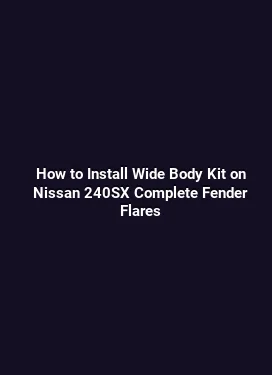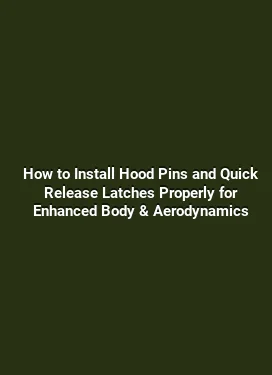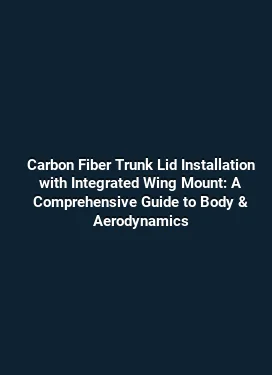How to Install Splitter Rods and Supports for Track Day Durability
Track days demand equipment that can endure high-speed runs, variable surfaces, and the aerodynamic forces that come with aggressive driving. Splitter rods and their supporting structures play a pivotal role in maintaining predictable front-end behavior while safeguarding the splitter from impact and fatigue. This article walks through practical installation strategies, material choices, mounting methodologies, and performance considerations that help ensure durability without compromising downforce or balance on track. Real-world techniques, measured tolerances, and maintenance routines are provided to guide both amateur enthusiasts and seasoned builders toward repeatable, reliable performance.
Foundational Principles of Splitter Rods and Supports

Splitter rods and their supporting hardware establish a stable link between the aerodynamic element at the car’s front and the chassis. The primary goals are to distribute loads effectively, minimize flutter at high speeds, and keep the splitter aligned under a variety of driving loads. In practice, this means selecting materials with sufficient rigidity, designing mounting points that avoid excessive deflection, and coordinating the rod geometry with the vehicle’s existing aero package. When installation is done with attention to these principles, the splitter becomes a predictable source of downforce rather than a source of resonance or misalignment during mid-corner transitions.
Durability hinges on understanding load paths. Front-end loads at speed are not merely vertical; they include lateral and torsional components that travel through the splitter to the rods and into the mounting structure. A well-integrated system distributes these forces across multiple points, reducing concentrated stress. The result is a splitter that stays true through repeated track sessions, even when kerbs, ripple strips, or mid-race braking events test the drivetrain and aero. For builders, this translates to a design that can tolerate both routine maintenance and occasional impulsive loads without constancy of alignment changes or material fatigue.
Material Selection: Balancing Stiffness, Weight, and Heat Tolerance
Materials for splitter rods and supports must strike a balance between stiffness, weight, corrosion resistance, and heat tolerance. Common choices include aluminum alloys with high strength-to-weight ratios, tempered steel for stiffness and resilience, and certain composite laminates where high stiffness-to-weight performance is needed without adding excessive weight. Each material carries trade-offs: aluminum offers lightness but can suffer from galling at fastener interfaces or corrosion in salty environments, while steel provides robust fatigue resistance at the cost of weight. Composite options bring excellent stiffness and damping properties, yet require meticulous bond and fastener compatibility to prevent delamination or galvanic issues.
When selecting materials, consider the operating window of the track day environment. Heat buildup at the front of the car can affect fasteners and protective coatings, so choose materials and coatings that resist heat soak and maintain dimensional stability. A typical approach is to use corrosion-resistant alloys with protective finishes in conjunction with hardware that has compatible hardness ratings to avoid embedded wear at contact points. This careful pairing of materials helps ensure longevity under repeated high-load events and reduces the likelihood of microcracks forming in high-stress areas.
Geometry and Alignment: Achieving Predictable Aerodynamics
Rod geometry governs how forces are transmitted to and from the splitter. The alignment should minimize interference with the vehicle’s core airflow while preserving the intended downforce profile. A common practice is to run a combination of upper and lower rods that form a triangulated, rigid frame for the splitter. This configuration reduces the risk of wobble and helps maintain splitter angle through steering inputs and braking events. During installation, precise measurements are critical. Use alignment jigs, dial indicators, and calibrated spacers to ensure the rods are parallel to the splitter face and that the attachment points maintain consistent spacing under load. This level of precision keeps aerodynamic performance stable across a range of track conditions.
In addition to straight-line stiffness, torsional resistance is vital. The front end experiences twisting forces as the suspension compresses and the vehicle transitions from corner entry to exit. A well-designed rod system resists these twists without causing the splitter to sag or misalign. The result is a front aero package that remains predictable and easy to tune, which is essential for repeated, confident lap times during track days.
Mounting Techniques: Fasteners, Interfaces, and Safety Margins
Mounting splitter rods requires a thoughtful approach to fastener selection, interface materials, and load distribution. Stainless steel or coated fasteners are common for their corrosion resistance and fatigue properties, but the choice must harmonize with the mounting points on the chassis and the splitter itself. It is important to avoid galvanic corrosion by selecting compatible metals for mating components. The use of lok-tightened or locking hardware can prevent fastener rotation and maintain clamp load under dynamic loads. Where possible, incorporate load-distributing washers or anti-slip bushings to reduce localized stress concentrations that could lead to microcracking over time.
Interfaces should provide a balance between secure attachment and serviceability. Quick-release or easily accessible fasteners can expedite routine inspections between track sessions, while still maintaining the required clamping force during high-speed runs. Consider incorporating sacrificial wear surfaces at contact points to absorb minor impacts and shield the more integral structure from direct damage. A practical approach is to create a layered interface: a load-spreading plate, a compliant washer, and then the fastener, enabling controlled micro-movements without transferring harmful stresses into critical components.
Practical Mounting Scenarios and Common Mistakes

In practice, mounting scenarios vary with chassis geometry and splitter design. Common mistakes include over-tightening, which can strip threads or warp the splitter, and under-tightening, which allows micro-movements that degrade aero stability. Another frequent issue is misalignment caused by unequal mounting heights, leading to uneven load distribution. A robust method is to perform a staged torque sequence, gradually increasing clamp load while verifying alignment with a laser height gauge or a calibrated ruler. This method yields repeatable results and minimizes the risk of distortion during assembly.
Installation Steps: A Practical Walkthrough
Begin with a clear plan that maps each mounting point, the associated fasteners, and the expected clamp loads. Record baseline measurements of the splitter alignment and the car’s front ride height to set a reference before any work begins. Disassemble the existing front aero components only as needed, then install the rod system in stages, starting with the most rigidly supported points to establish a stable reference frame. Use a combination of thread-locking compounds sparingly and only on specified areas to avoid attracting debris or impeding future maintenance. After each mounting phase, recheck the alignment and ensure the splitter remains parallel to the reference plane. A final sweep should confirm consistent gaps around the splitter edge and alignment with neighboring aero elements to prevent interference during high-speed runs.
After assembly, perform a dynamic check that simulates track-day loads. This can be accomplished with a controlled bump test on a testing rig or by carefully loading the car through a controlled range of steering and braking inputs on a flat surface. The aim is to observe any flutter, unusual noises, or shifts in alignment, which would indicate the need for torque recalibration or a revision to rod geometry. Document the results for future adjustments and to inform maintenance schedules. A well-executed installation yields a robust, tuneable aerodynamic setup that respects the overall balance while enhancing front-end stability during demanding sessions.
Maintenance, Inspection, and Longevity Strategies
Durability is built through proactive maintenance. Regular inspections should focus on fastener torque, wear at interface materials, and any signs of corrosion. Inspect rod contact points for fretting or micro-movements, which can indicate that clamping force is not being maintained or that the mounting surfaces are developing wear patterns. Replace any elements showing significant wear, and keep a log of torque values and inspection findings to support trend analysis over multiple track days. In addition, track-specific adaptations—such as heat shields around fasteners or protective coatings for exposed steel—can further extend service life in harsh environments.
Cleaning and conditioning are part of longevity. Use non-abrasive cleaners and avoid harsh chemicals that can degrade coatings or gaskets. After exposure to salt or corroding conditions, rinse and dry parts thoroughly to prevent premature degradation. If removable protective covers are used, verify their fit remains tight and undisturbed after each session. A simple, repeatable maintenance routine ensures the splitter system remains aligned, resilient, and ready for future track days without requiring extensive rework.
Performance Outcomes: Balancing Downforce, Stability, and Speed
When splitter rods and supports are properly installed, drivers notice a more stable front end, especially during heavy braking and mid-corner transitions. The robustness of the mounting system reduces the likelihood of aero-induced pitch changes that can upset balance. The impact on top speed is often indirect but meaningful: a predictable aero response allows drivers to push deeper into corners with confidence, translating into more consistent lap times and repeatable setups across varying track conditions. For teams and enthusiasts alike, the ability to tune downforce levels by altering rod geometry or attachment points can open pathways to optimizing grip and speed on different circuits without sacrificing durability.
In the broader scope of vehicle dynamics, the splitter system works in concert with other aero components, suspension geometry, and tire behavior. A harmonious integration ensures that changes in one area do not produce unintended consequences in another. By treating the splitter rods and its supports as part of a comprehensive aero package—carefully engineered, precisely assembled, and diligently maintained—track-day durability becomes a tangible, measurable attribute that supports both performance and reliability.






